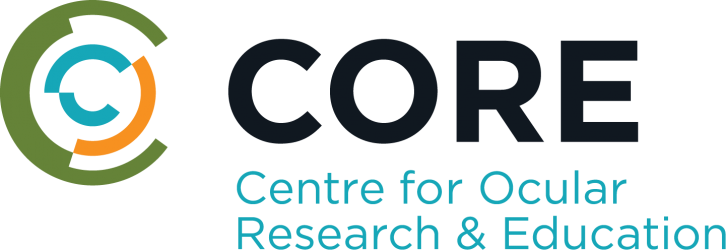WATERLOO, Ontario, June 12, 2023— As ectatic corneal diseases—such as keratoconus—pose significant challenges to vision and quality of life, the Centre for Ocular Research & Education (CORE) has dedicated Issue 72 of Contact Lens Update to better understanding the underlying causes and advancements in treatment methods for its successful management. The bi-monthly publication is available at no charge by visiting ContactLensUpdate.com.
“With a multidisciplinary approach that includes early diagnosis, monitoring, patient education, and advancements in contact lenses and surgeries, we can offer better visual outcomes and significantly improve the quality of life for patients affected by ectatic corneal diseases,” said Daddi Fadel, DOptom, FSLS, FBCLA, FAAO, FIACLE, a clinical scientist at CORE. “Prompt diagnosis and regular monitoring are essential for successful outcomes with corneal crosslinking in halting the progression of keratoconus. Additionally, educating patients about the significance of avoiding eye rubbing is crucial for preventing and managing the disease effectively.”
Advancements in managing ectatic corneal diseases offer a variety of tailored contact lens options. Personalized fitting, including scleral lenses, is crucial for optimal outcomes by improving vision and addressing high-order aberrations associated with these conditions. As our understanding of ectatic corneal diseases continues to evolve, it is vital for eye care practitioners to stay updated with the latest developments and provide personalized solutions for the best possible care of patients with these complex conditions.
Fadel, a pioneer of modern lens designs, editor-in-chief of the Journal of Contact Lens Research & Science, and author of several peer-reviewed articles and books, writes the issue’s opening editorial. She presents a comprehensive review of ectatic diseases, providing a detailed summary of the current understanding, diagnosis, and treatment of ectatic diseases, including therapeutic contact lenses and surgical approaches. The editorial provides an up-to-date overview of the field, making it a valuable resource for clinicians and researchers involved in the management of ectatic diseases.
Melissa Barnett, director of optometry at the University of California, Davis, an internationally recognized expert in specialty and scleral lenses, dry eye disease, keratoconus, and presbyopia, provides the feature article that delves into the management of keratoconus through contact lenses, highlighting the significance of corneal topography and imaging techniques in optimizing lens fitting. The feature article provides valuable perspectives on current approaches and strategies for effectively managing keratoconus with contact lens interventions.
Karen Carrasquillo, senior vice president of clinical and professional affairs at BostonSight, adjunct clinical professor at the New England College of Optometry and at the School of Optometry, MCPHS University, shares her expertise in the form of a clinical insight. This comprehensive case report highlights key considerations in managing keratoconus patients, emphasizing the importance of addressing both mechanical and optical aspects of the lens fit. Proper weight distribution, minimizing suction, and optimizing visual quality with customized optics are crucial factors for effective treatment.
The conference highlight is shared by Christine Sindt, professor of clinical ophthalmology and director of the Contact Lens Service at the University of Iowa Department of Ophthalmology and Visual Sciences. This poster compared different methods of measuring higher-order aberrations (HOAs) on scleral lenses and their impact on fitting and functionality, showing that both high-resolution aberrometer (HRA) and low-resolution aberrometer (LRA) improved HOAs measurements. The wavefront lens based on HRA measurements corrected 50% more HOAs compared to that based on the LRA measurements.
In addition to a complete archive of back issues, ContactLensUpdate.com offers a resource library that provides no-cost professional tools, patient resources, images and video. It also houses complimentary technical training videos produced by the International Association of Contact Lens Educators, plus an industry glossary. Industry professionals can access the latest issue directly from ContactLensUpdate.com or quickly sign up for email receipt of future issues.
The publication receives support from the educational arms of Alcon, Cooper Vision, and Johnson & Johnson Vision.
# # #
About the Centre for Ocular Research & Education (CORE)
The Centre for Ocular Research & Education (CORE) was established in 1988 at the University of Waterloo’s School of Optometry & Vision Science. Over the next three decades, the organization evolved from a three-person operation into a thriving hub of basic and applied research, collaborating with sponsors, agencies and academia on advanced biosciences, clinical research and education. Its uncompromising independence and results of the highest quality have been at the heart of many of the most prominent advances in eye health. Today, its approximately 50-person team serves a range of ophthalmic sectors, including medical devices, ocular pharmaceuticals, digital technology and others, with a focus on the anterior segment. For more information, please visit core.uwaterloo.ca.
MEDIA CONTACTS
Aimee J. Lewis or Mike McDougall, APR, Fellow PRSA, McDougall Communications for CORE
aimee@mcdougallpr.com +1.585.414.9838 | mike@mcdougallpr.com +1.585.545.1815





